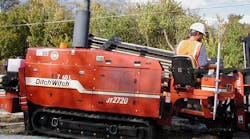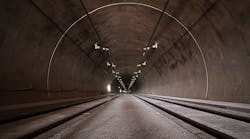Fayetteville, located in mid-southern Tennessee, sits right along U.S. Highway 64. This community of 7,000 has been in the midst of a major highway reconstruction project for the past two years.
Back in the mid 1980s, the Tennessee Department of Transportation began an initiative to widen this primary east-west route serving southern Tennessee. The project spanned 10 counties from Memphis to Grundy County's I-24. In total, more than 266 miles of the highway would be widened to a four-lane route. The goal? Help stimulate growth and economic development in the region.
Tennessee is known for its music, food, whiskey, and rock. Yes, parts of Tennessee are full of high-quality limestone — and that rock proved to be a major challenge on this job.
Enter Mike Herren, president of Mid South Utility Contractor in Baxter, TN. Herren got his start in the underground business in 1992, doing odd jobs with his backhoe. In 1993, he got his first break and took over the maintenance work for a local water utility district. Soon he was installing water, sewer, gas, and telecommunications lines throughout the region. Today, Mid South Utility Contractor specializes in the installation of water, sewer and gas lines and is know for their expertise in boring — especially in rock.
20 BoresMid South Utility Contractor was contracted to relocate all of the water, sewer and gas lines along a 6-mile stretch of U.S. 64 through Fayetteville. His crews installed 2.5 miles of sewer, 3 miles of force main sewer, 3 miles of natural gas lines, 2.5 miles of waterline and 42 manholes. The project took two years and put Herren's boring skills to the test.
"The majority of the lines were open cut, but we had to complete 20 bores ranging from 60 feet to 120 feet in length under the highway," says Herren. "The bores accounted for 30 percent of our work on the project."
The project required Mid South Utility Contractor to install 20-foot sections of steel casings, ranging from 12 inches to 30 inches in diameter. The water lines were installed under the highway at a depth of 6 feet to 8 feet, while the sewer lines had to go in at 15 feet to 20 feet on grade.
"We've been auger boring a long time in rock, but not at the precision that we had to be on these gravity sewer lines," says Herren.
To help them handle the project, Herren worked with McLaughlin to bring in and customize McLaughlin's rock system for use on the project.
Rock Boring SystemThe McLaughlin rock system was designed specifically for solid rock applications. The system utilizes a pilot head with three roller cones set up to cut 6-1/2 inches on the outside diameter (OD). Behind the pilot head are two 5-foot-long stabilizers with ribbing on them to bring them up to the OD of the pilot head. When drilling forward, the stabilizers fill the void created by the pilot head and steady it for an accurate shot. The pilot head and stabilizers are attached to a drill stem that allows water to flow through to the head, flushing the cuttings and keeping the pilot head cool. Herren used the rock system with his McLaughlin 36-42C auger boring machine.
Crews began the sewer bores by creating and shoring a pit 20 feet deep by 32 feet long. The pit was set 10 feet back from the new road. Once the pit was set, the boring machine was positioned.
Mike Moore, vice president of sales for McLaughlin, was on hand to train the crew on how to use the rock system.
"Since you cannot steer the auger," Moore said, "setting up the machine is key." He added, "It needs to be in a straight line in the direction you want to go and at the grade of the bore. We also had to make sure the machine was square. This takes the most time, and the rock will keep you in once you get the machine square."
Once the pilot head was square, the crew began boring and continued to add drill stem until they reached the other side of the road. When they reached the receiving pit at the other side of the road, they continued to rotate the pilot head forward and began pulling the stem back out of the hole.
"During this process we pumped water from the receiving pit back toward the machine to help flush out any remaining cuttings," says Moore.
Completing The BoresWhen the pullback was complete, the rib stabilizers and pilot head were left in the hole and a 16-inch reamer head was attached. The reamer head featured a series of roller cones up to the OD. On the back side of the reamer, the crew attached a standard auger and the first 20-foot section of casing. The crew began to ream the hole and continued to pump water from the receiving pits back into the boring machine to keep the head cool and flush the cuttings back into the pit. The 20-foot sections of casing were welded together as the bore progressed.
"The pilot hole is the slowest part of the process," says Herren. "It takes a couple of days to get the pilot hole completed and a total of four days to complete each bore."
Once the new main lines were in place, the Mid South Utility Contractor began the process of laying new service lines to each home and business along the route. The new lines and old lines were in service until all customers were connected to the new lines. The old lines were then abandoned to keep service disruptions to a minimum.
"It was a pretty mean job, I'll just put it that way," says Herren. "This project was right in the middle of town among all the homes and factories, so we had limited space to work. But the system worked well and helped us successfully complete the project."




